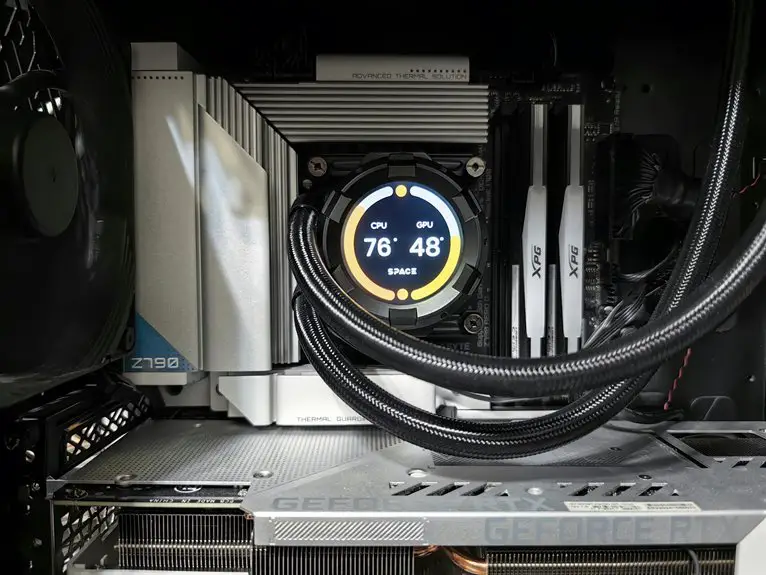When you're deciding between integrated and dedicated graphics, it's crucial to think about what you'll be using your system for. Integrated graphics can handle everyday tasks quite well, while dedicated graphics offer the power needed for more demanding applications. But how do you determine which option is best for your specific needs? Understanding the differences in performance, cost, and use cases can help you make that choice. Let's explore these aspects further.
Table of Contents
Key Takeaways
- Integrated graphics are cost-effective and suitable for everyday tasks like web browsing and video streaming.
- Dedicated graphics cards provide superior performance for gaming and graphic-intensive applications, enhancing visual quality and frame rates.
- Consider future upgrade potential; integrated graphics may limit performance, while dedicated options can adapt to evolving software demands.
- Evaluate power consumption; integrated graphics are energy-efficient, making them ideal for portable devices and longer battery life.
- Assess your specific needs; choose integrated graphics for casual use or dedicated graphics for demanding tasks like gaming and content creation.
Understanding Integrated Graphics
What do you really know about integrated graphics? Integrated graphics are built into your computer's CPU, allowing it to handle basic visual tasks without needing a separate graphics card. This setup's great for everyday activities like browsing the web, watching videos, or working on documents.
You'll find integrated graphics in most laptops and budget desktops, making them cost-effective options.
However, they do have limitations. If you're into gaming or graphic design, you might find their performance lacking. Integrated graphics share system memory, which can slow things down when multitasking.
Still, for casual users, they provide a solid balance of performance and energy efficiency, making them a practical choice for everyday computing needs.
Exploring Dedicated Graphics Cards
When it comes to serious gaming or demanding graphic design tasks, dedicated graphics cards are the way to go. These powerful components take the load off your CPU, ensuring smoother performance and better visuals.
Here are three key benefits of dedicated graphics cards:
- Enhanced Performance: With dedicated memory and advanced processing power, these cards handle complex graphics efficiently, making games and design software run seamlessly.
- Superior Visual Quality: Dedicated GPUs support higher resolutions and advanced graphic settings, allowing you to enjoy stunning visuals and immersive experiences.
- Future-Proofing: Investing in a dedicated graphics card means you're better prepared for upcoming software and games that demand more power, ensuring longevity in your system's capabilities.
Choosing a dedicated graphics card can significantly elevate your overall computing experience.
Performance Comparison
When you compare graphics performance, you'll want to look at benchmarks that highlight key differences in gaming capabilities and rendering speeds.
Understanding these metrics helps you make an informed choice for your needs.
Let's break down what each of these factors means for your overall experience.
Benchmarking Graphics Performance
As you dive into benchmarking graphics performance, understanding how different components interact is crucial for making informed decisions.
You'll want to consider several factors that significantly impact performance:
- Frame Rate: Measure how many frames your system can render per second. Higher frame rates lead to smoother visuals.
- Resolution: The higher the resolution, the more pixels your graphics processor has to handle. This can affect performance depending on your setup.
- Rendering Quality: Different settings, like texture quality and anti-aliasing, can change how demanding a game or application is on your graphics card.
Gaming Capability Differences
Understanding the differences in gaming capability among graphics cards can help you make the right choice for your setup.
Integrated graphics are great for casual gaming, handling lighter titles and older games with ease. However, if you're aiming to play the latest AAA games or want to experience high frame rates, dedicated graphics cards are the way to go.
They provide superior performance, allowing for higher resolutions and better graphics settings. Dedicated cards often come with their own memory, which significantly enhances game performance.
In short, if gaming's a priority for you, investing in a dedicated graphics card will ensure a smoother and more immersive experience compared to what integrated options can offer.
Rendering Speed Analysis
While choosing a graphics card, you should pay close attention to rendering speed, as it directly impacts your overall gaming experience.
Rendering speed determines how quickly frames are processed and displayed, which can make or break your enjoyment.
Here's a quick performance comparison:
- Integrated Graphics: Generally, they offer lower rendering speeds, suitable for casual gaming and everyday tasks, but may struggle with demanding games.
- Dedicated Graphics: These cards excel in rendering speed, providing smoother gameplay and higher frame rates, making them ideal for serious gamers.
- Game Optimization: Some games are optimized for specific graphics cards, which can enhance rendering speed, so always check compatibility.
Choosing the right card based on these factors will ensure you get the best performance for your gaming needs.
Cost Considerations
When considering graphics options, you'll want to weigh the initial investment against the long-term value.
It's crucial to assess how much you're willing to spend upfront and what benefits you'll reap over time.
Balancing these factors can help you make a more informed decision.
Initial Investment Differences
Choosing the right graphics options often requires weighing the initial investment, which can vary significantly based on your specific needs.
When considering integrated versus dedicated graphics, you'll find key differences in upfront costs:
- Integrated Graphics: Usually included with the CPU, making it a budget-friendly option. You won't have to spend extra on a separate graphics card.
- Dedicated Graphics: Offers superior performance but comes with a higher price tag. Depending on the model, you might pay anywhere from $100 to $1000 or more.
- Future Upgrades: Keep in mind that dedicated graphics may require more investment upfront but can be essential for high-demand applications, influencing your choice based on the tasks you intend to perform.
Long-term Value Analysis
Understanding the long-term value of your graphics options is crucial, especially as technology evolves and your needs may change.
When considering integrated versus dedicated graphics, think about the overall costs over time. Integrated graphics tend to save you money upfront, but they may struggle with demanding applications in the future, leading to potential upgrades sooner than expected.
On the other hand, dedicated graphics come with a higher initial investment but often provide better performance and longevity, making them a more cost-effective choice in the long run.
Evaluate your usage patterns, such as gaming or professional applications, to determine which option aligns best with your budget and future requirements.
Investing wisely today can save you significant expenses tomorrow.
Use Cases for Integrated Graphics
Integrated graphics can be a practical choice for many users, especially if you're looking for a cost-effective solution without requiring high-end performance.
Here are a few scenarios where integrated graphics shine:
- Everyday Tasks: If you primarily use your computer for browsing, word processing, or streaming videos, integrated graphics will handle these tasks effortlessly.
- Casual Gaming: For light gaming or older titles, integrated graphics can provide a satisfactory experience without the need for a dedicated GPU.
- Portability: If you're using a laptop, integrated graphics often lead to better battery life, making it ideal for on-the-go productivity.
In these cases, integrated graphics offer a reliable balance of performance and efficiency, allowing you to get the job done without breaking the bank.
Use Cases for Dedicated Graphics
For many users, dedicated graphics cards are essential for achieving optimal performance in demanding scenarios.
If you're into gaming, a dedicated card can handle high-resolution textures and complex graphics, providing smoother gameplay and better frame rates.
For content creators, whether you're video editing or 3D modeling, dedicated graphics significantly reduce rendering times and enhance real-time previews.
Additionally, tasks like machine learning or data visualization benefit from the extra processing power dedicated cards offer.
If you enjoy virtual reality or immersive simulations, dedicated graphics are crucial for maintaining realistic visual fidelity.
Making the Right Choice for Your Needs
When considering your graphics options, it's important to assess your specific needs and usage patterns.
Your choice between integrated and dedicated graphics hinges on a few key factors:
- Performance Requirements: If you're gaming, video editing, or running graphic-intensive applications, dedicated graphics will likely serve you better.
- Budget Constraints: Integrated graphics are generally more affordable and can handle everyday tasks like browsing and streaming without a hitch.
- Power Consumption: Integrated graphics consume less power, making them ideal for laptops and energy-efficient setups.
Frequently Asked Questions
Can Integrated Graphics Be Upgraded or Replaced?
No, you can't upgrade or replace integrated graphics since they're built into the CPU. If you want better performance, you'll need to consider a dedicated graphics card instead for a significant boost in graphics capabilities.
How Do Integrated Graphics Affect Battery Life in Laptops?
Integrated graphics typically consume less power than dedicated options, so they help extend your laptop's battery life. When you're doing light tasks, you'll notice improved longevity, making them ideal for everyday use and portability.
Are There Any Compatibility Issues With Integrated Graphics?
You shouldn't face major compatibility issues with integrated graphics. Most modern applications and games support them well, but older software might struggle. Always check system requirements to ensure smooth performance for your specific needs.
Do Integrated Graphics Support Multiple Monitors?
Yes, integrated graphics can support multiple monitors, but it depends on your motherboard and the specific integrated graphics capabilities. Check your hardware specifications to ensure you can connect and configure multiple displays effectively.
How Do Drivers for Integrated Graphics Differ From Dedicated Graphics?
Drivers for integrated graphics typically come bundled with your system's operating system, while dedicated graphics require separate installations. You'll often find dedicated drivers offer more advanced features and optimizations tailored for high-performance tasks.




